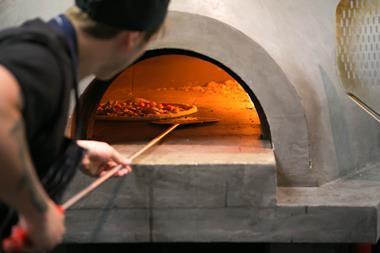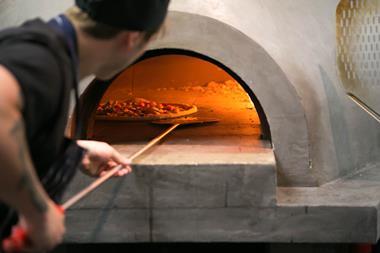When is a pizza restaurant a pizza restaurant and not a pizzeria? According to the Oxford English dictionary, never; they are one and the same. According to Alan and Mark Wogan, however, they are distinctly different. The pair run the street stall-born Homeslice, which now comprises three restaurants, in conjunction with concept founder Ry Jessup. They insist what they are doing is most definitely a pizza restaurant and most definitely not a pizzeria.
“We open local pizza restaurants. They are not pizzerias – we don’t serve pasta and none of us is Italian, so we are not held to any rules and what goes on the menu is whatever we are inspired by,” Mark tries to explain.
He admits that the ubiquitous Margherita pizza is one of the top sellers (“If you can’t cook that, then you shouldn’t be making pizza at all”), but everything from the other toppings on offer (a recent special was wild venison, which Mark says caused a social-media backlash but turned out to be very popular, and the current menu sports Xo pig cheek with collard greens and crackling furikake); to the surroundings and style of service are pretty far removed from most people’s idea of a traditional pizzeria.
An oven at its heart
The Fitzrovia restaurant in Wells Street, north of London’s Oxford Street, like the two others, has a wood-fired pizza oven at its heart and the feel is very relaxed and streety, with big wooden tables and basic yet stylish décor and accessories. The 20 inch pizzas are served whole on a wooden board and customers eat them from paper plates. They all cost £20, although three –the Margherita; salami, rocket and parmesan and a third choice that changes regularly (currently mushroom, ricotta, pumpkin seed and chilli) – are also offered at £4 a slice. Drinkwise, there is one lager and one frizzante on tap, plus a choice of one red wine, one white and one rosé by the glass (£4); demi-litre (£14) or litre (£28). These are complemented by bottled local craft ales at £5, a range of soft drinks at £2 each and a bottle of sparkling water for £3.
“We always ensure we retain the DNA of our street-food roots – the focus and simplicity of it is what appeals to us as restaurant-goers as much as it does as people who run restaurants,” Mark explains. He adds that they both love how eating out in London has changed in recent years, with a raft of operators with a pared back but quality offering, in all different food categories, enabling more people to eat decent meals at a reasonable price.
As the sons of the late, great Sir Terry Wogan, Mark and Alan and their sister Katherine, were, Alan says, well used to dining in a variety of restaurant as they grew up. He says their mother’s very good home cooking had equal, if not more, influence on their respective careers – with all three of them now in the restaurant industry (Katherine, formerly an actress, runs three pub restaurants plus another restaurant with her husband Henry).
Mark got into cooking for a living in his late teens, starting – after a course at Leiths School of Food and Wine – as a junior chef at the first ever Carluccio’s. He became head chef at Ebury Group, set up an outside catering firm, finishing as executive chef of The Groucho Club, and then had a variety of cooking shows on TV before working on media and business development for a number of chefs.
Early career moves
Following an early career as a radio and television newscaster and business journalist for the BBC, Financial Times, Bloomberg and NBC, Alan moved into the business side of the media and still has a few media and creative agency interests. He has previously had shareholdings in the restaurant sector alongside Mark in Longshot, when it owned The Groucho, and in several pubs and restaurants in London. He says 99% of his time is now devoted to Homeslice, where he is responsible for the business side of things. Mark is totally immersed in the pizza restaurants now, where his role is about maintaining standards and developing the brand.
The pair were keen to work together in their own restaurant business. Not only are their individual skills complementary, so too are their personalities – they share a dry sense of humour, recognisable from their dad, coupled with an unspoken but obvious mutual understanding, the kind that can only come from being close relatives.
Mark had met Jessup when he was a customer at Flat White, the coffee shop operator, where Jessup was working. Jessup had hand-built his mobile wood-fired pizza oven which soon proved so popular at markets and festivals that, in 2012, it secured a residency at Kings Cross Filling Station. Mark and Jessup recognised the opportunity to create a permanent home for Homeslice, which is when the two Wogan brothers came on board to make it happen. The Neals Yard site came up and they spotted the potential of what was then very much an off-prime location and got the investment together (about £200,000) to open the first restaurant, with 45 seats inside and a further six outside, in May 2013.
Just before this, Mark and Alan had raised “a lot of money” for an all-day dining concept they were planning to open in Mayfair – chefs and managers had been employed but the lease was sold to someone else at the 11th hour. They originally planned to run this alongside Homeslice but, despite the stress and disappointment at the time, they are now glad the other restaurant did not come to fruition.
“It allowed us to have the time to react to the speed at which Homeslice got busy and to attend to all the things that need to be done to control everything and keep standards high in a fast-growing business,” Alan says.
Mark adds that they did not expect to have to turn away so many people at the door in their launch week. The restaurant hit its sixth month target by week three, with tables turning as much as ten times a day.
Average spend per head
Across the three Homeslices open today, the average spend per head is £13, with 70% of that going on food. The food spend is a bit higher at Neals Yard as dwell time is shorter. Both Fitzrovia, which opened in 2015, and the newest restaurant, which opened shortly after in Old Street, Shoreditch, have more seating plus basements that allow greater flexibility and enable the restaurants to offer cocktails.
“We have certainly challenged ourselves with properties,” Alan laughs. “We opened the third restaurant 12 weeks after the second – it was an ‘interesting’ time. We now feel better prepared in terms of how to approach a refurb and what to spend the budget on.”
Financial constraints also made it necessary for them to look at locations that were not of obvious appeal to more established operators. So far, Alan seems to have demonstrated a flair for pre-empting the increasing popularity of off-beat areas, like Neals Yard and Fitzrovia.
They have always tried to cut their cloth accordingly and as they have made money, they have reinvested it to help maintain standards as the business grows – a new till system has just been installed, for example, an experience Alan wryly describes as “tons of fun for everyone”.
Homeslice has also recently exchanged contracts for two new sites. The first, due to open early October, will be a restaurant with 80 seats inside and a few more outside. It will be within the building housing the European HQ for Bloomberg, the financial software, data and media firm, near St Paul’s and slap bang between three tube stations. The City outlet will be the firm’s first new build and they are looking forward to the design freedoms that will allow.
The firm’s fifth site, due to open early next year, will be just as exciting and more than a little poignant for Mark and Alan. It will occupy 1,400 square feet on one floor within the redevelopment of BBC Television Centre in White City, a place so inextricably linked with their father.
Expansion ambitions
The Wogans’ early Mayfair experience has made them reticent to trumpet any other potential locations until things are at an advanced stage legally. Alan says he has looked at sites outside London, “but we want to make sure we have got the business to the right size for a head office function to support that.”
For sites to be of interest and to justify the investment required (now circa £500,000 per restaurant) in relation to revenue opportunities from the brand’s relatively low price point, they need to be a minimum of 1,000 square feet and a maximum of 3,000 square feet. Alan says the payback period on their restaurants so far has been between two and three years..
There are opportunities to grow business within the existing sites, which currently serve some 8,000 customers a week and produce net annual revenue well in excess of £4m. Alan says deliveries currently account for 10% of sales but have the potential to become much more. Homeslice has chosen Supper as its delivery partner – like the pizza operator, it is quite a new business; most of the restaurants it delivers for are quality independents and, very importantly, explains Alan, it has temperature-regulated delivery boxes large enough for Homeslice’s 20-inch creations.
Mark adds that Homeslice is also looking at various collaborations with other brands that might help raise the profile and awareness of the business, although he says it has already grown into something he didn’t expect.
Alan agrees and says he is really enjoying the success of their venture: “It is exciting when someone talks about Homeslice and doesn’t know you are involved. That has happened to me lately - and I haven’t heard anyone say they don’t enjoy it.”
When the Television Centre restaurant opens, the likelihood of people not making the connection between the brand and the Wogans will surely diminish. The ambition of increasing brand recognition will also be given a boost. Homeslice, has every chance of making its mark as a funky, quality pizza restaurant operator, however you want to define it.








































